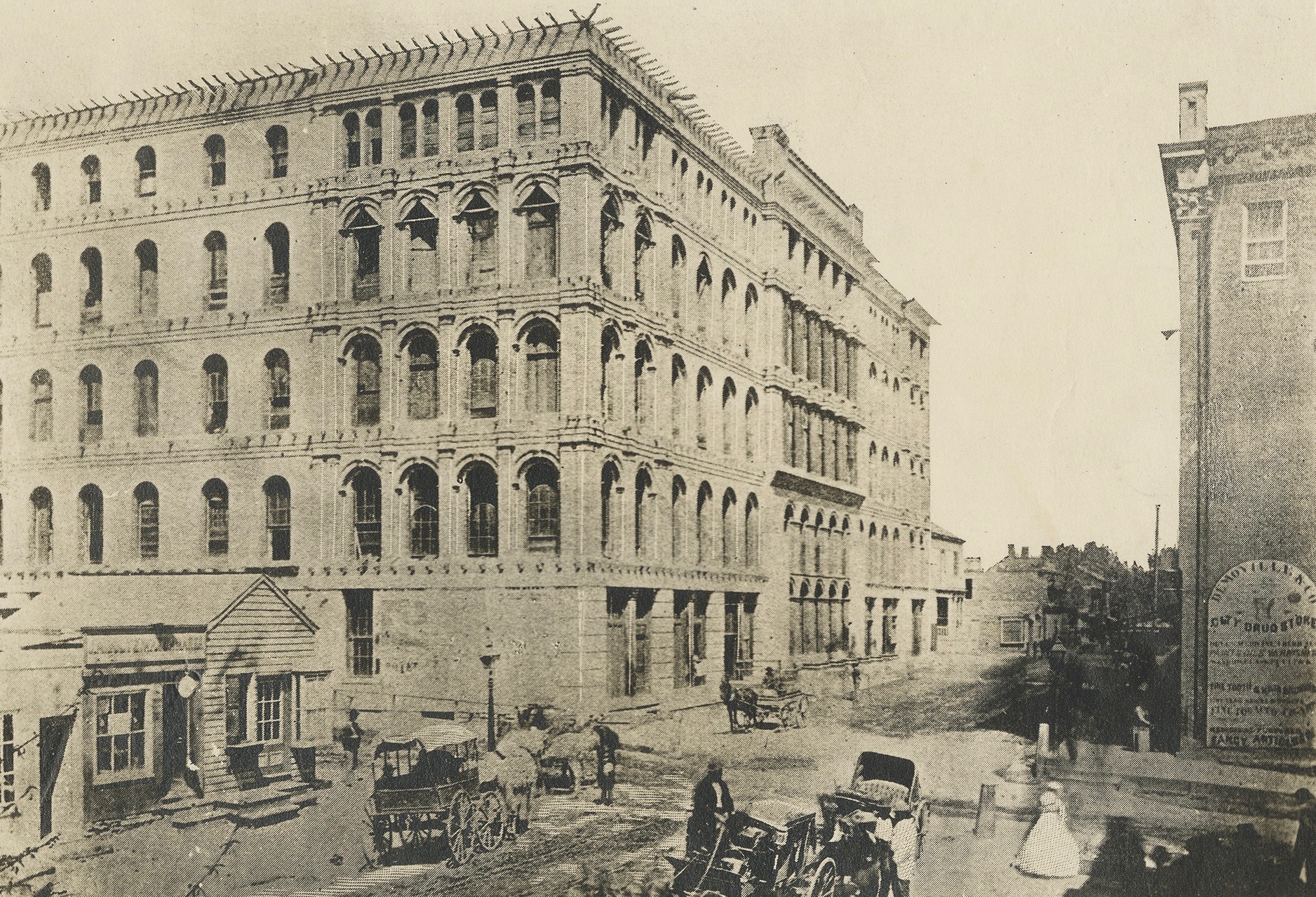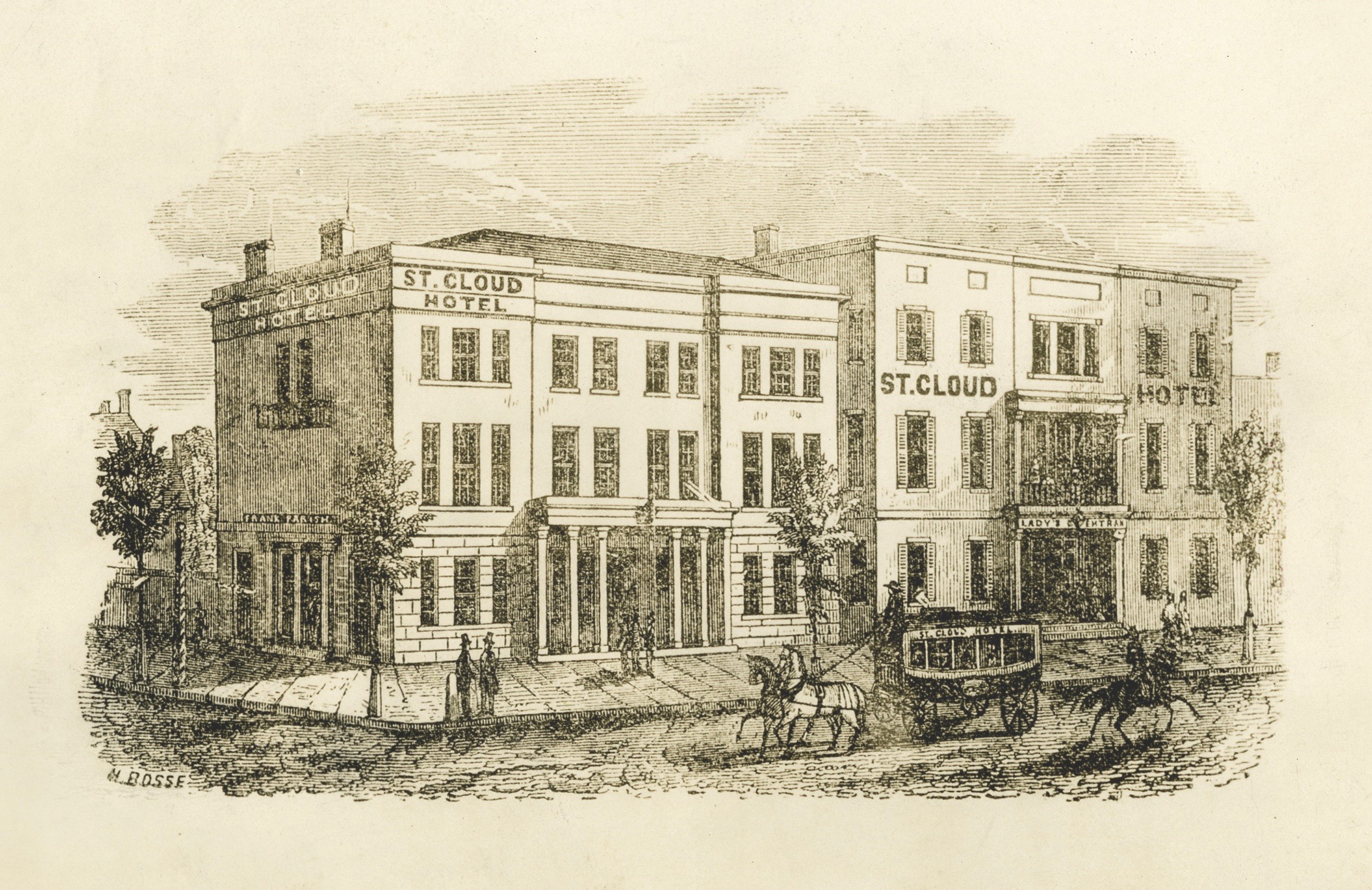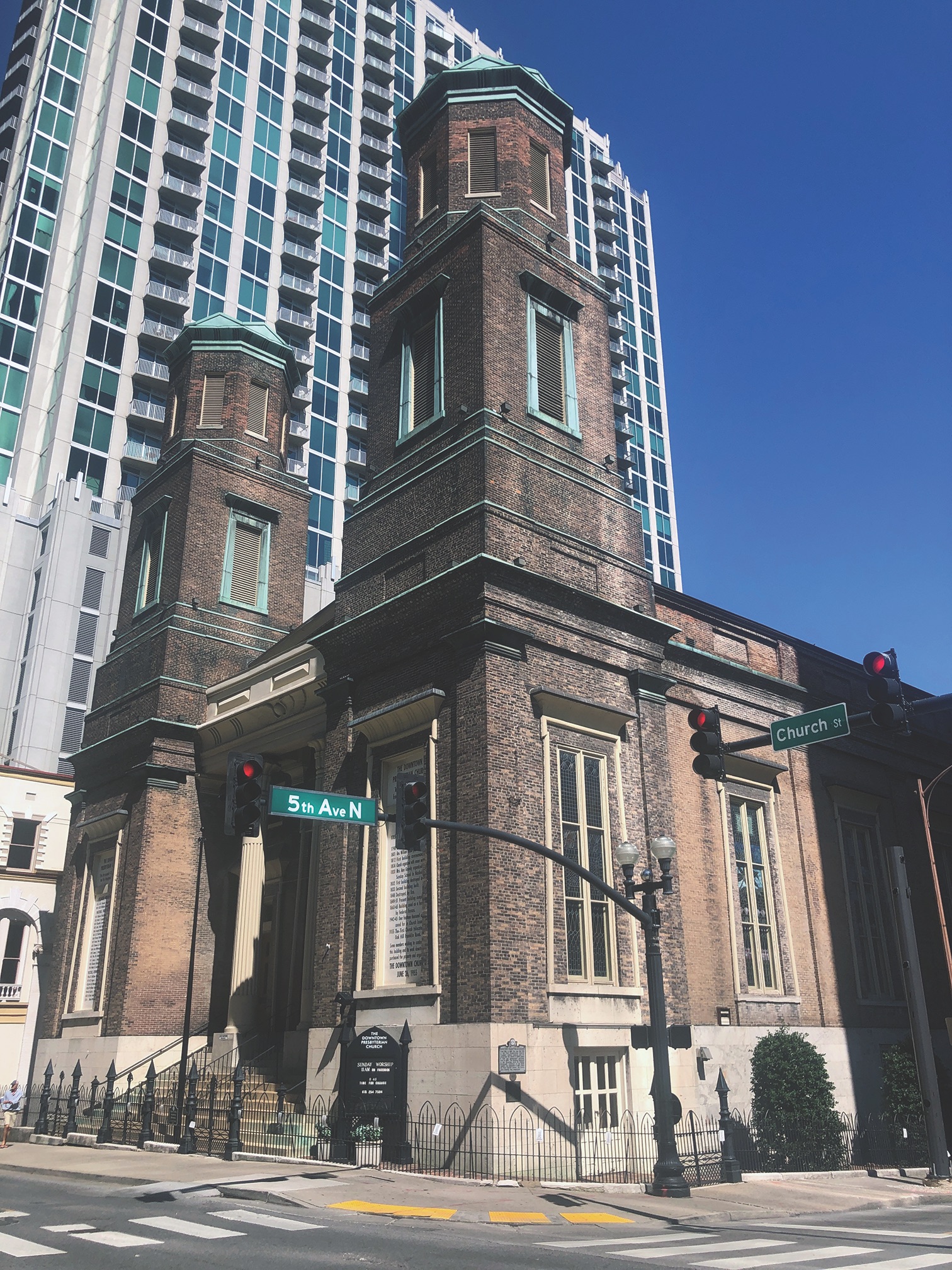Early on a Friday evening in Nashville, I stand in the bullseye of history on the corner of 5th Avenue and Church Street. Two blocks south stands the Ryman Auditorium, once home of the Grand Ole Opry. A short distance north, 124 black civil rights protesters were refused service in 1960 during a sit-in at the lunch counter of F.W. Woolworth’s five-and-dime store.
A block to the east, pioneers struggled against attacking Indians in 1781 during the Battle of the Bluffs. And to the northwest, around the block and past the city park, Ulysses S. Grant made his 1864 headquarters in the home of a Confederate sympathizer.
But, oh, what mostly forgotten Civil War history occurred merely steps from where I stand.
The lone reminder of the Maxwell House Hotel is a black-and-white painted historical marker mounted on the outside of a modern office building on Church Street. Once one of the grandest hotels in the South, it was destroyed by fire on Christmas Day 1961.
From its opening in 1869 to the early 1900s, the Maxwell House was the go-to site for the most important people in society. Presidents Rutherford Hayes and William McKinley, both Civil War veterans, were guests, as was former slave trader and Confederate cavalry commander Nathan Bedford Forrest, who took the oath to the Ku Klux Klan in a ceremony in Room No. 10.
In the spring of 1870, the farm of former Confederate Lt. Gen. Richard Ewell—who lived in Spring Hill, 35 miles south of Nashville—supplied the Maxwell House Hotel with 100 pounds of fresh butter a week. Seven years earlier, “Old Bald Head” supplied us with unending controversy by not taking Cemetery Hill at Gettysburg. The hotel also was the setting for a little-known Civil War tragedy.
Construction on the Maxwell House began in 1859, using mostly enslaved labor, but stopped when the war began. Before they abandoned the city in early winter 1862, Confederates used the unfinished, five-story brick building as a barracks. After Federals occupied Nashville, it continued to house troops and was used as a supply depot as well.
“Zollicoffer’s Barracks,” the Yankees called the place, after Confederate General Felix Zollicoffer, a Nashville citizen who was killed at the Battle of Mill Springs, Ky., in January 1862.
From the outside, the place looked appealing. Inside, it was a dump.
“In many places the tiling of the rooms was cracked and broken where fires had been built on the floor for warming purposes, and having been used for so long as a barracks, the building was alive with vermin,” former 1st Wisconsin Cavalry Quartermaster Sergeant James Waterman wrote decades after the war. “The whole thing was more like a prison than a barracks for civilized beings, and was a disgrace to the service.”

In the fall of 1863, the grimy barracks housed hundreds of Confederate POWs, many from the September 19-20, 1863, Battle of Chickamauga. On the morning of September 29, disaster struck as POWs were being herded near a fifth-floor stairwell for breakfast. Barracks commander John Lakin, a captain in the 89th Ohio, may have warned the Confederates about the rickety flooring, but none apparently listened if he did.
Crack! A temporary wood floor suddenly gave way, sending prisoners plummeting to the second floor.
“I fell lengthwise between two joists, and a man fell across me,” former POW John M. Dickey of the 44th Tennessee recalled years later. “His brains were scattered over my coat, and the spots were on it when I left prison in 1865. I lay pinned until the rest of the wounded and dead were cared for.” Dickey, who was taken to the Central Baptist Church for care, couldn’t stand up for nearly a month because of his injuries.
“The sight was one of the most appalling ever witnessed, except on the battlefield, one man having his head mashed flat as a board, others frightfully bruised or mutilated,” the Nashville Dispatch reported the next day. Days later, the Nashville Press described the scene as “one quivering mass of bleeding, mangled humanity.”
News of the accident spread throughout the city. Guards were placed around the building, and ambulances rushed to the site to take “misguided and suffering Confederates” to a prison hospital.
“Here they were attended by our surgeons and nurses with all the kind and tender care that could have been shown a Federal soldier wounded under the Stars and Stripes fighting for the Union,” the pro-Union Press reported. “The secesh ladies also waited on them with an untiring devotion that would reflect honor on a more righteous cause.”
There were conflicting accounts of the number of dead—one indicated as many as 45 were killed; another said 25, while others said less. Dozens were injured.
“Some were between the floors and were mashed almost to jelly,” a 10th Texas Cavalry veteran recalled. “The patriotic women of Nashville were soon there, and gave the Yankees a good round of abuse for placing prisoners in a trap to kill them, rather, as they stated, than meet them on the field of battle. I never placed any censure on the Yankees for this unfortunate occurrence, as it was purely accidental and unexpected.”
Decades after the tragedy, a former POW remained bitter. “I will never forget how the guards pushed the good women of Nashville with their bayonets,” recalled W.C. Jennings about the ladies who had aided the injured.
Less than 50 yards down Church Street, no historical marker denotes the location of St. Cloud Hotel, which closed its doors in 1873.
When Union forces occupied Nashville in early 1862, the three-story hotel briefly became headquarters for Maj. Gen. Don Carlos Buell. An undertaker visited the St. Cloud “every day to receive the consignments of Federal corpses from neighboring battlefields,” the Nashville Tennessean reported.
“They came in, often three carloads at once,” the newspaper wrote about the bodies, “and were stacked up, one upon the other, like cord wood….”
Early on the icy morning of December 15, 1864, Maj. Gen. George Thomas, nicknamed the “Sledge of Nashville,” checked out of the St. Cloud Hotel and headed to the front to pummel John Bell Hood’s army on the first day of the Battle of Nashville.

At the corner of 5th and Church, catty-corner from the St. Cloud Hotel site, stands the historic Downtown Presbyterian Church. A sign on front of the Egyptian Revival building notes its long history. Three skyscrapers tower over the historic building that was once the city’s tallest.
Life-and-death decisions played out at the church, one of at least 25 Nashville structures commandeered by the Union for use as a military hospital. Pews were removed, creating room for 206 beds; the basement was used as a stable for army horses.
The church, along with the long-gone, four-story Masonic Hall across the street, was designated Hospital No. 8. Here, nurses and doctors cared for soldiers suffering from wounds and diseases such as typhoid, which killed thousands of soldiers during the war.
On March 25, 1865, weeks before Lee surrendered to Grant at Appomattox, a small slice of humanity in the midst of war took place in Ward 5. At
4 p.m., attendants and patients were assembled for the presentation of an inscribed silver watch, chain, and key to acting assistant surgeon George Duzan, a 23-year-old from Indiana in charge of the ward.
The gift, which cost $75, a significant sum, was in recognition of Duzan’s “kind attention and skillful treatment” and “gentlemanly deportment” at Hospital No. 8, according to hospital chaplain Thomas Goodfellow.
“[W]hen these brave but afflicted donors have separated, this ward broken up, and this cruel rebellion crushed,” he said, according to the Nashville Daily Union, “may you look upon this gift with as a kind remembrance of these men, as is now felt by them, in presenting it.”
Duzan, who served with the 52nd Indiana, was touched. “I accept it as testimonial of your appreciation of my services,” the young doctor said. “As such it will be preserved and cherished with feelings of gratitude and pride.”
Just another faint echo of the past at 5th and Church. ✯
John Banks is the author of the popular John Banks’ Civil War blog.





